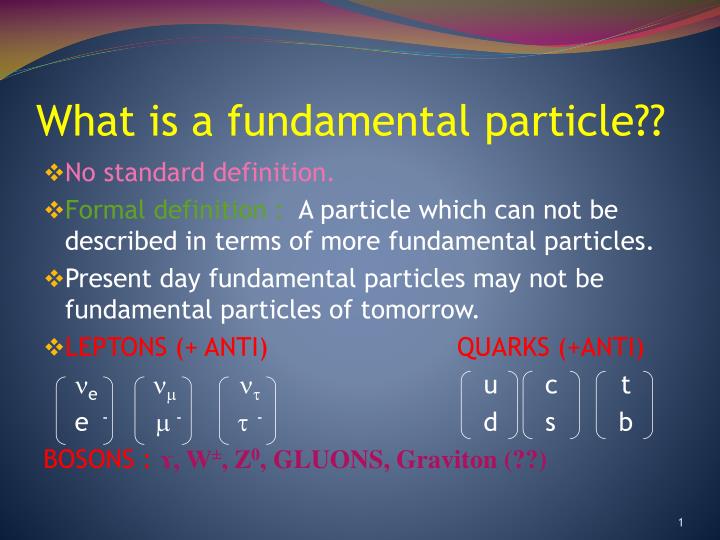Fundamental particles are often described as the building blocks of the universe; this reflects both their ubiquitous nature and their enigmatic character. Engaging with the question of what these particles are made of reveals layers of complexity and interconnections that captivate physicists and laypeople alike. At the most elemental level, fundamental particles, categorized as fermions and bosons, defy the conventional frameworks of material composition and challenge our understanding of existence.
Fermions, which include quarks and leptons, make up the matter that constitutes the physical universe. Quarks combine to form protons and neutrons, the constituents of atomic nuclei, while leptons, such as electrons and neutrinos, play vital roles in the structure of atoms. Unlike macroscopic entities, which are typically made of atoms or molecules, fundamental particles may be considered to be “bare” in the sense that they are not composed of smaller constituent elements. Instead, they exist as elementary entities, characterized by properties such as mass, charge, and spin, yet devoid of any substructure.
At the heart of the fascination surrounding fundamental particles lies the question of their properties and interactions. The Standard Model of particle physics serves as the prevailing theoretical framework that describes these particles and their interactions through four fundamental forces: electromagnetic, weak, strong, and gravitational. Each particle corresponds with specific interactions, dictated by the forces with which they engage. For example, photons are the carriers of the electromagnetic force, while W and Z bosons mediate weak interactions fundamental to processes of decay and nuclear fusion.
A pivotal aspect of understanding fundamental particles lies in recognizing that energy and matter are interchangeable, as articulated by Einstein’s equation, E=mc². This principle permeates our understanding of particle physics; it posits that fundamental particles are not merely made of “material” in the conventional sense but are manifestations of energy moving at high velocities through space-time. In a sense, they can be understood as excitations in quantum fields. This insight introduces a critical consideration: the nature of mass and the mechanics behind its origin.
The Higgs boson, famously heralded as the “God particle,” plays an essential role in this narrative. The Higgs field permeates the universe, and fundamental particles acquire mass through their interactions with this pervasive field. When particles interact, they experience resistance—analogous to moving through a medium—thereby giving rise to mass. This property challenges the layperson’s conception of mass derived from tangible material, suggesting instead that mass is a relational attribute emerging from the interaction with an omnipresent field.
It is worth noting that discussions surrounding fundamental particles often evoke philosophical ponderings about the nature of reality. The very definition of “material” is undermined when one acknowledges that at the subatomic level, particles can exhibit wave-like behavior, appearing as probability distributions rather than individuated entities. The wave-particle duality inherent within quantum mechanics invites deeper inquiries into the essence of substance—what it means for something to be “made of” a particular material when, at its core, it may be more appropriately described as a manifestation of probability.
Furthermore, the interplay of forces and particles gives rise to the formation of complex structures. Emerging theories, such as supersymmetry, propose additional layers of particles that could explain the unification of forces and provide greater clarity into dark matter, an elusive substance that constitutes approximately 27% of the universe yet has yet to be directly observed. The interplay of fundamental particles in this ballet of cosmic forces reflects an interconnected tapestry whose materiality transcends traditional boundaries.
Indeed, the intrigue surrounding fundamental particles fuels ongoing research and experimentation within particle physics. Particle accelerators, such as the Large Hadron Collider, serve as colossal instruments of inquiry, colliding particles at unimaginable speeds to unveil the behaviors and interactions of fundamental constituents. Such experiments not only reaffirm existing theories but also pave the way for groundbreaking discoveries that challenge our comprehension of material reality.
The search to understand what fundamental particles are made of invariably leads us down a labyrinthine path of scientific exploration—a pursuit where physics meets philosophy. It beckons inquisitiveness and humility, for the quest reveals both the limitations of human perception and the grandeur of natural phenomena. As we peel back the layers of existence, we may find that the essence of these particles, gauged from past to future, invites not only intellectual examination but also a spiritual reverence for the intricate design of the cosmos.
In summation, fundamental particles resist simple categorization under the framework of material composition. They embody the dual nature of energy and mass, reflecting the principles embedded within the Standard Model. Understanding their properties, interactions, and underlying fields, like the Higgs field, reveals complexities that challenge our conventional notions of substance. This discourse delves through compelling physics, revealing not merely the physical structure of the universe but also engaging the profound philosophical implications of our existence. The material of fundamental particles is not merely what they are made of but rather how they embody energy and interact with the core fabric of reality.












